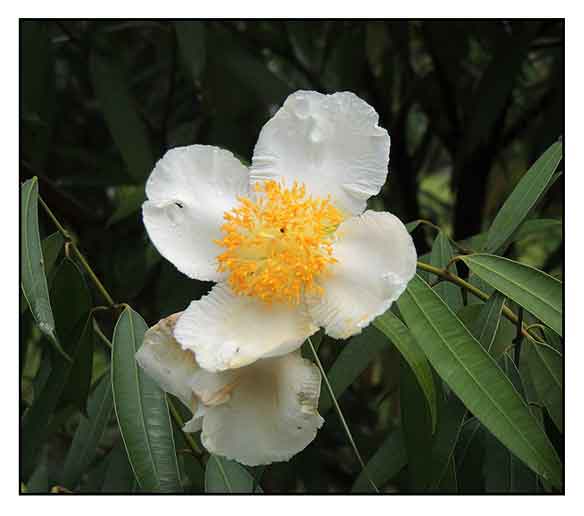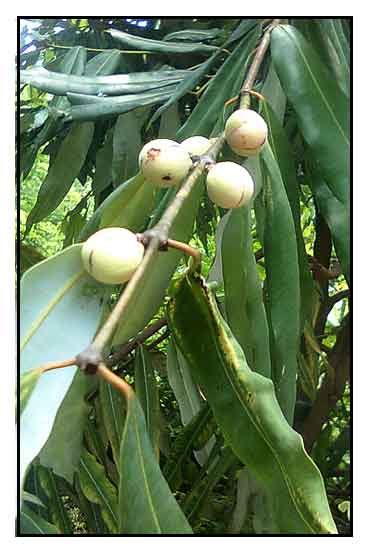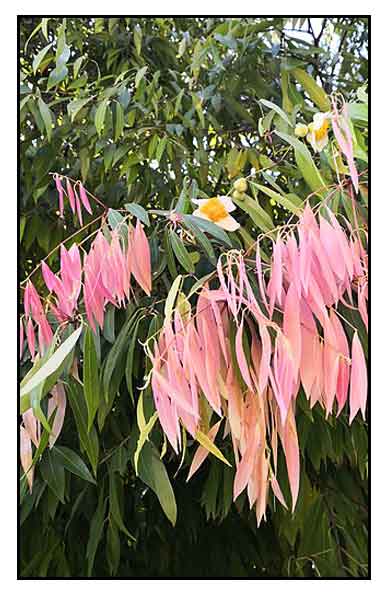 Gen info Gen info
- In Theravada Buddhism, the tree is said to be used to achieve enlightenment or Bodhi by four Lord Buddhas i.e., Mangala, Sumana Sobhitha, and Revatha. (41)
- In Sri Lanka, the pillars of the 14th century Embekke Shrine near Kanday are made of iron tree wood. (41)
Botany
Mesua ferrea is a medium to large tree that can grow to a height of 18 to 20 m. Bark is reddish-brown to gray that peels off in thin flakes. Leaves are simple, long-petioled, oblong, lanceolate, acuminate, rounded at the base, thick, coriaceous, upper surface lustrous, lower surface greenish or covered with a waxy, ash-colored powder. Emerging young leaves are red to yellowish pink and drooping. Flowers are bisexual, 4 to 7.5 cm in diameter, terminal or axillary, solitary, with four white petals, and a center of numerous orange yellow stamens. Fruit is an ovoid to globose capsule, nearly unilocular,, encompassed at its base by the sepals, the lower part of the petals, and crowned by the style. Pericarp woody, dehiscent at the tip by 2–4 valves; contains 1–4 seeds, slightly orbiculate, coriaceous.
Distribution
- Common in forests.
- Widely cultivated as an ornamental for its pink foliage and fragrant flowers.
- Native to Sri Lanka, India, Nepal, Myanmar, Thailand, Indochina, Philippines, Malaysia.
C constituents constituents
- Phytochemical screening yielded phenyl coumarins, xanthones, triterpenoids, fats and flavonoids as main constituents.
- Phytochemical screening of various seed extracts yielded alkaloids, saponins, phenolics, tannins, flavonoids, and terpenoids. (see study below) (1)
- Total terpenoid content of stamens was estimated at 102.8 mg/ml of dried extract (in terms of lupeol equivalents).
(see study below) (12)
- Hydrodistillation of leaves for essential oil had 0.064% yield of a yellow liquid. GC-MS analysis identified 35 constituents, constituting 81.4% of total volatile components. Major constituents were trans-caryophyllene (30.9%), ß-caryophyllene oxide (17.9%), α-humulene (6.0%), δ -cadinene (4.1%), y-muurolene (3.5%), y-cadinene (2.3%), ß-selinene (1.9%), germacrene D (1.8%), and ß-bisabolene (1.6%). (see study below) (19)
- Study compared the antioxidant activity of various extracts from various parts of M. ferrea. On antioxidant capacity in DPPH assay, high polar solvent exhibited highest DPPH radical scavenging activity. The methanol extract of leaves showed highest activity with IC50 of 89.94 µg/mL. The ME of leaves also showed highest total flavonoids with 325.79 mgQE/g. The ME of flowers and DCM extract of fruits showed higher total phenolic contents, 769.11 mg GAE/g and 703.62 mg GAE/g, respectively. (21)
- Preliminary screening of seed extracts yielded fixed oil, coumarins, carbohydrates, and saponins. (see study below) (26)
- Study of M. ferrea bus by column chromatography isolated 13 compounds, namely:
3, 4-dihydroxy-benzoic acid (1), catechin (2), isovitexin (3), quercitrin (4), multifidol glucoside (5), lysidiciside A (6), ochrocarpins F (7), 5, 7-dihydroxy-8-(2-methylbutyryl)-4-phenylcournarin (8), 5, 7-dihydroxy-6-(2-methylbutyryl)-4-phenylcournarin (9), mesuol cyclo F (10), quercetin (11), luteolin (12) and isodispar A (13). (32)
- Study of root bark of M. ferrea isolated seven xanthones: mesuaferrin A (1), mesuaferrin B (2), mesuaferrin C (3), caloxanthone C (4), macluraxanthone (5), 1,5-dihydroxyxanthone (6) and tovopyrifolin C (7). (34)
- Study of root bark isolated
two new pyranoxanthones, mesuaferrin A (1), and mesuaferrin B (2), along with five other compounds, caloxanthone C (3), 1,8-dihydro-3-methoxy-6-methylanthraquinone (4), ß-sitosterol (5), friedelin (6), and betulinic acid (7). (36)
- Study of ethyl acetate extract of Mesua ferrea isolated five new isomeric polycyclic polyprenylated acylphloroglucinols (PPAPs), namely: mesuaferroic acid A, B, C, E, and F (1-5). (see study below) (37)
Properties
- In various folk medicine, considered antiseptic, anti-inflammatory, blood purifier, anthelmintic, diuretic, expectorant, antipyretic, purgative, antiasthmatic, antiallergic, cardiotonic. (7)
- Studies have suggest antimicrobial, cytotoxic, antioxidant, anticancer, anti-arthritic, wound healing, immunomodulatory, anti-inflammatory, analgesic, antiprotozoal properties.
Parts used
Leaves, bark, fruit, flowers, seeds..
 Uses Uses
Edibility
- Seeds are edible, eaten well-cooked.
- Fruit edible; wrinkled when ripe.
- Young leaves edible; has sour and astringent flavor.
Folkloric
- Almost all plant parts traditionally used medicinally for various ailments.
-
Dried powdered flowers mixed with oil or lard used as ointment and applied to hemorrhoids. (•)
- In Malaysia, poultice of seed oils or crushed kernels applied for wound healing. Flower and root decoction used after childbirth. In Thailand, seeds used as cardiotonic, expectorant, and wound healing. In Ayurveda, used as immunity booster. Used for headache hiccup, itching, sweating, scabies, skin problems, tumors. Bark used for treatment of cough, dysentery, sore throat and vomiting. In Bangladesh, powder of dried fruit and leaves mixed with ghee used for relief of burning sensations in the hands and feet, and joint pains.
(23)
- Used as aphrodisiac; hemostatic in menorrhagia.
- In Ayurvedic medicine, used for treatment of pain, inflammation, and rheumatic conditions.
- In India, traditionally used as antiseptic, anti-inflammatory, anti-asthmatic and antiallergic. It is an ingredient in ayurvedic formulations like Brahma Rasayana and Chyavanprash, which are used to improve immunity. (9)
- Used by the tribal people of Odisha, India
for treatment of diarrhea and dysentery.
- Used in many parts of the world for treatment of cutaneous infections, sores, scabies, wounds, etc. (18)
- The Temuan tribe in Peninsular Malaysia drink decoction of seed oil, root and flowers after childbirth. Decoction of dried flowers rubbed on external skin complaints.
(22)
- In Thai traditional medicine, used to treat fevers, cold, asthma; used as diuretic, carminative, expectorant, cardiotonic, and antipyretic. (25)
- Leaves and flowers used as antidotes for snake bites and scorpion stings. Decoction, infusion, or tincture of bark and roots used as bitter tonic and for treatment of gastritis and bronchitis. (25)
Others
- Seed oil: Seed oil used as substitute for petroleum gasoline. Polymer from seed oil used in the preparation of resins.
- Wood: Moderately durable; resistant to termites. Hard to saw. Used for making railroad ties, construction like posts, beams, rafters, joists, and columns; flooring, furniture, cabinetry, tool handles, among many others. Also used as firewood.
- Crafts: Flowers and stamens used as pillow stuffing. (•) In Nag Champa, used for making incense sticks. (41)
- Illuminant: In Assam, India, seeds used for daily lighting before the introduction of kerosene by the British. (41)
Studies
• Antimicrobial / Seeds: Study evaluated the antimicrobial potential of seven different solvent extracts of M. ferrea seeds using disc diffusion method. Gram-positive bacteria were most susceptible while yeast were most most resistant. Antimicrobial activity was more pronounced with non-polar solvents than polar ones. (3) Study evaluated various extracts of seeds of Mesua ferrea in vitro against gram positive and gram negative bacterial strains and some fungal strains. Proteus vulgaris and Bacillus subtilis were the most sensitive strains to the hexane and methanolic extract with maximum zones of inhibition. The methanolic extract was most sensitive against Aspergillus niger and A. flavus. (see constituents above) (11) Study evaluated the antimicrobial potential of M. ferrea seed extracts against a wide spectrum of microbial strains. Lipophilic extracts showed more activity towards gram-positive bacteria. Activity was attributed to the presence of essential oil, xanthones, and coumarins. (26)
• Cytotoxicity / Human Cholangiocarcinoma Cell Line / Seeds: Study investigated the cytotoxic activities of crude ethanolic extracts of 28 plants and 5 recipes used in Thai folklore medicine. against human cholangiocarcinoma (CL-6) and human laryngeal (Hep-2), and human hepatocarcinoma (HepG2) cell lines in vitro. 5-fluorouracil was used as positive control. Seven plants, including Mesua ferrea, showed promising activity against CL-6 cell line. Mesua ferrea showed potent cytotoxic activity with IC50 of 48.23 µg/ml. The sensitivity to other cancerous cell lines varied according to cell types . (4)
• Antiarthritic / Seeds: Study evaluated the antiarthritic activity of M. ferrea in formaldehyde and Complete Freund's Adjuvant (CFA)-induced arthritis in rats. Results showed M. ferrea protects rats against formaldehyde and CFA-induced arthritis. (5)
• Antioxidant / Leaves: /Study investigated the total phenolic, alkaloid content and in-vitro antioxidant activity of various extracts of M. ferrea leaves. The ethanol (70%) extract of leaves showed more phenolic and alkaloidal content than the other extracts. Antioxidant activity was evaluated using different free radicals i.e., superoxide, hydroxyl, and DPPH. The plant extracts exhibited concentration dependent percentage inhibition of different free radicals and produced maximum activity at a concentration of 1,280 µg, increasing gradually to maximum level with higher concentrations. (6)
• Wound Healing / Dried Flowers: /Study investigated the wound healing activity of ethanolic extract of dried flowers of Mesua ferrea on excision and incision model in albino rats using a 5% and 10% w/w ointment formulation. Both concentrations showed significant results in both wound models. Nitrofurazone ointment was used as standard. (8)
• Antioxidant / Immunomodulatory / Mesuol /from Seed Oil: Study evaluated the immunomodulatory activity of mesuol isolated from M. ferrea seed oil in experimental animals. In the humoral immune response model, mesuol evoked a significant dose dependent increase in antibody titer values in cyclophosphamide-induced immunosuppression. In the cellular immune response model, there was increase in paw edema volume in the cyclophosphamide-induced immunosuppressed rats treated with SRBC. Mesuol potentiated percentage neutrophil adhesion and phagocytosis in carbon clearance assay. Results indicated immunomodulator activity of mesuol. (9)
• Anti-Inflammatory / Roots: Study showed that the root aqueous extract of Mesua ferrea exerted an anti-inflammatory effect on CD14 monocyte marker in human PBMCs with a dosage-dependent manner. Macrophage activation through B cell mitogen i.e. lipopolysaccharide (LPS, agonist of TLR4 receptor) results in the release of proinflammatory cytokine (TNF-alpha). The aqueous extract suppressed TNF-a secretion at higher doses. At high doses, the aqueous extract showed hemolytic activity (10)
• Antibacterial / Stamens: Study of various extracts of Mesua ferrea stamens showed the n-hexane extract to possess significant bactericidal and antioxidant activities. The activities may be attributed to the presence of steroids, terpenoids and volatile oil components and higher total terpenoid content. Acute toxicity study using OCD guidelines showed safety up to 2000 mg/kbw in Swiss albino mice. (see constituents above) (12)
• Acute Toxicological Study / Dried Flowers: Study evaluated acute toxicity of dried flowers of M. ferrea in female Swiss albino mice using OECD guidelines screening measures of body weight, food consumption, hematological and biochemical parameters with doses of 50, 500 and 2000 mg/kg. Results showed no adverse effect on clinical observation and no mortality to treated animals. (13)
• Analgesic Activity: Study evaluated the analgesic activity of M. ferrea extracts using acetic acid induced writhing in mice models. The n-hexane extract of M. ferrea administered orally to mice produced significant antinociceptive action against acetic acid-indued visceral pain. Acetic acid acts by releasing endogenous mediators that stimulate the nociceptive neurons. The nociceptive activity of acetic acid may be due to release of cytokines, such as TNF-a, IL-1ß and IL-8 by resident peritoneal macrophages and mast cells. The antinociceptive action of the n-hexane fraction may be due to inhibition of release of the cytokines. (14)
• Potent Antibacterial / Weak Antiprotozoal /Activity: Study extracted a series of 4-alkyl and 4-phenyl 5,7-dihydroxycoumarins from Mesua ferrea blossoms. Compounds 1-9 were showed weak antiprotozoal activity against Plasmodium falcifarum and potent antibacterial activity on resistant gram-positive strains. (15)
• Inhibitory Potential on Antigen Specific Immune Response / Leaves: Study evaluated the effect of variable doses of aqueous extracts of leaves of Mesua ferrea and Mimusops elengi on human lyzed whole blood to determine antigen (IBD, infectious bursal disease, virus derived from chicken) specific immune response. Results showed both exhibited dose dependent decline in antigen specific immune response including CD14 monocyte surface marker. (16)
• Anticonvulsant / Flowers: Study evaluated the anticonvulsant activity of ethanolic extract of Mesua ferrea flowers in albino mice using MES (Maximum Electroshock Seizure) test. Results showed significant (p<0.001)dose-dependent inhibition of MES-induced convulsions. (17)
• Anti-Inflammatory / Flowers: Study evaluated an ethanolic extract of flower of M. ferrea for anti-inflammatory activity using carrageenan induced rat paw edema . The flower extract at dose of 400 mg/kbw showed maximum anti-inflammatory action. (18)
• Anticancer / Antibacterial / Antioxidant / Leaf Essential Oil: Essential oil from leaves of M. ferrea was isolated by hydrodistillation. GC-MS analysis yielded 35 constituents. DPPH radicals scavenging assay showed antioxidant activity with IC50 of 31.67 mg/mL. The EO showed significant antibacterial activity against e. coli and S. aureus with MICs of 250 and 125 mg/mL, respectively. The oil also exhibited anticancer activities against KB, MCF-7, and NCI-H187 cell lines with IC50s of 24.02, 16.19, and 20.32 µg/mL, respectively, with no toxicity to cell line. (see constituents above) (19)
• Apoptosis and Inhibition of Metastasis / Human Colorectal Carcinoma / Stem Bark:Study evaluated the molecular mechanisms for the anticancer activities of M. ferrea stem bark extract against human colorectal carcinoma (HCT116) cells. α-Amyrin and betulinic acid contents from sub-fraction (SF-3) were measured by HPLC methods. Fluorescent assays revealed apoptotic features and marked decrease in mitochondrial membrane potential in SF-3 treated cells, along with increased levels of caspases-9 and -3/7 levels. SF-3 showed promising antimetastatic properties in multiple in vitro assays. Growth inhibitory effects were also observed which further suggests in vivo antitumor efficacy of SF-3 phytoconstituents. Results suggest the anticancer effects of SF-3 towards colon cancer are through modulation of multiple molecular pathways. (20)
• Water Disinfectant Properties / Seed Oil: As a result of disinfection byproducts (DBP) concerns from chlorine, the EPA (Environmental Protection Agency) and water treatment industry have studies the use of disinfectants other than chlorine. This study evaluated the potential of Nahar seed kernel oil (NSKO) as an alternative natural disinfectant.. The NSKO emulsion demonstrated better disinfection and inactivation of bacteria in surface water and has good potential for usage as an alternative and natural disinfectant. Results showed the NSKO has a remarkable disinfection potential and kinetics studies suggested the NSKO fitted first-order model with a k value of -0.040. (24)
• Anti-Venom / Leaves: Study evaluated an aqueous extracts of M. ferrea leaves for activity against fibroblast cell lysis after Heterometrus laoticus scorpion venom treatment. Results showed efficiency in protecting against venom induced lysis (Uawonggul et al., 2006) (25)
• Anti-Arthritic / Seeds: Study evaluated various extracts of M. ferrea seeds for anti-arthritic properties in Complete Freund's Adjuvant (CFA) and formaldehyde-induced arthritic rats. LD50 cut-off dose was 3000 mg/kbw for all extracts. The petroleum ether extract of coat and kernels significantly reduced (p<0.01) the CFA-induced paw edema. Diclofenac sodium was used as standard drug. (see constituents above) (27)
• Immunosuppressive Activity against HBsAg / -Flavonoids / Leaves: Study evaluated the immunosuppressive activity of variable doses of crude flavonoids (6.25 - 100 mg/ml) extracted from the leaves of Mesua ferrea, Ficus benghalensis, and Jasminum auriculatum on human whole blood using using specific antigen i.e., hepatitis B vaccine containing surface antigen. The crude flavonoids extracted showed maximum inhibition of blood counts, CD14 monocyte marker and cytotoxicity at higher doses. Overall, all three plants showed immunosuppressive activity against HBsAg. (28)
• Acute Toxicity Study / Leaves: Study evaluated the acute toxicity of methanolic extract of leaves of Mesua ferrea in experimental female Swiss albino mice. Parameters measured were body weight, food and water consumption, hematological and biochemical parameters. Acute toxicity study did not cause death or acute adverse effect. (29)
• Effect on Growth and Morphology of Staphylococcus aureus / Leaves and Fruit: Study evaluated the antibacterial efficacy of leaf ad fruit extracts on the growth and morphology of Staphylococcus aureus. Both extracts exhibited good antibacterial activity with MIC of 0.048 mg/mL. Both were bacteriostatic at MBC of 0.39 mg/ml, which lasts for 24 hours. The extracts exhibited detrimental effects on the morphology of S. aureus, evidenced by extensive lysis of the cells, leakage of intracellular constituents, and aggregation of cytoplasmic contents forming an open meshwork of the matrix. (31)
• Anti-Inflammatory / Antioxidant / Bark: Study evaluated the in-vitro anti-inflammatory, antioxidant activities of ethyl acetate bark extract of M. ferrea using in-vitro 5-LOX and HRBC membrane stabilization assay. The ethyl acetate bark extract exhibited significant 5-LOX inhibitory activity and showed protective effect on the HRBC membrane stablization. The EA extract exhibited significant DPPH, ABTS, NBT and NO free radical scavenging activity. Phytochemical screening yielded high amount of phenolic content, flavonoids, terpenoids, and coumarins, which may be responsible for the anti-inflammatory and antioxidant activities. (33)
• Potential as Pharmaceutical Excipient in Lipid Based Nanoformulation / Seed Oil: Study reports on the application of M. ferrea seed oil as safe pharmaceutical excipient. LC-MS study suggest the oil is composed of fatty acids. MTT assay suggest the oil is safe for use at a cellular level in the living system. DSC and FT-IR study confirm the compatibility of the oil with the general components of the lipid nanooarticles. Study suggests the seed oil is safe for use in the pharmaceutical formulation. (35)
• α-Glucosidase Inhibitory Activity / Polyprenylatd Acylphloroglucinols: Study of ethyl acetate extract of Mesua ferrea isolated five new isomeric polycyclic polyprenylated acylphloroglucinols (PPAPs), namely: mesuaferroic acid A, B, C, E, and F (1-5). Compounds 4 and 5 exhibited good a-glucosidase inhibitory activity with IC50s of 0.43 and 0.60 mM, respectively. (37)
• Anti-Virulence Activity on Salmonella / Flowers: Study evaluated the anti-virulence activity of an ethyl acetate extract (EAE) of M. ferrea flowers on Salmonella. Ten purified compounds were identified and assayed for inhibitory activity against Type III secretion system (T3SS) by SDS-PAGE and Western Blot experiments. The biflavonoids, rhusflavanone and mesuaferrone B exhibited inhibitory effects on the secretion of Salmonella pathogenicity island I (SPI-1( effector proteins (SipA, B, C, and D) without affecting bacterial growth. (38)
• Antidiarrheal / E- coli-Induced Diarrhea / Flowers: Study evaluated the activity of aqueous extract of flowers in BALB/c mice with diarrhea induced by E. coli. The aqueous extract of flowers at concentration of 1.6% (w/v) showed significant inhibitory activity against Escherichia coli. Results support the use of nagasari flowers for the treatment of diarrheal diseases. (40)
Availability
Wild-crafted.
|

![]()




 constituents
constituents
